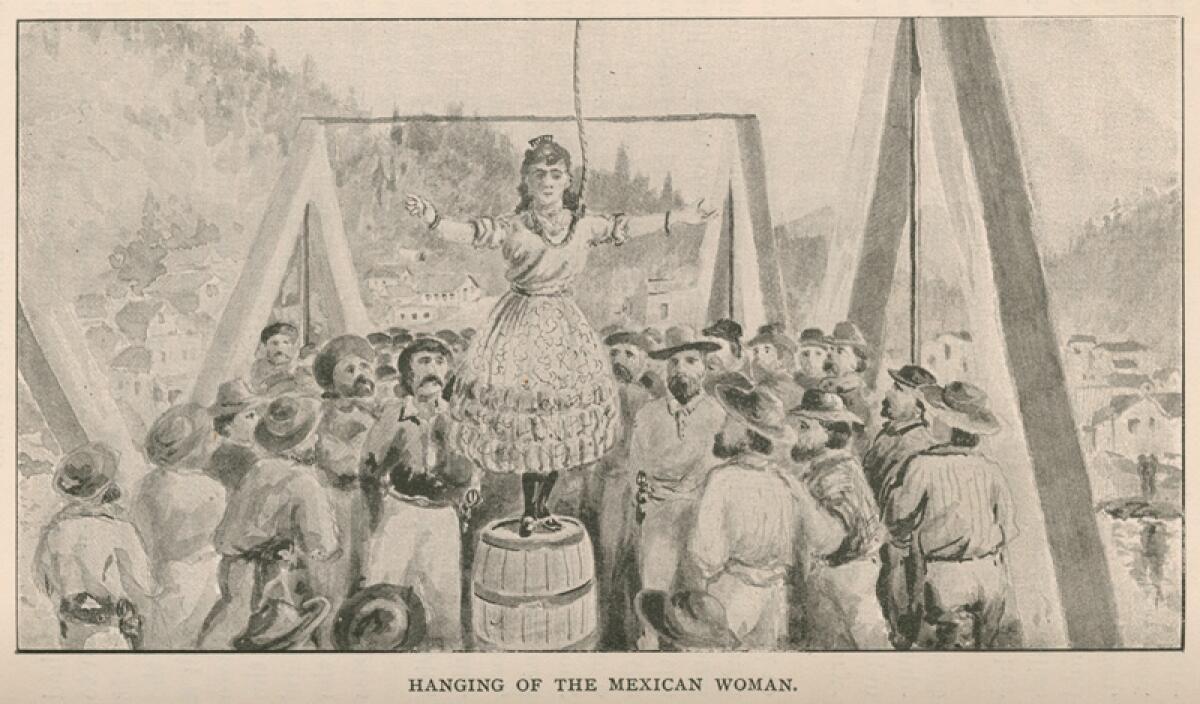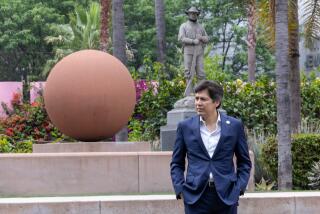Column: California has a history of racist lynchings too. Ignoring that fact is mass delusion

In 1861, near the intersection of what’s now Alameda and Aliso streets, a mob dragged, stabbed, then hanged 15-year-old Francisco Cota for allegedly killing a shopkeeper. Two years later, a crowd killed Charles Wilkins three blocks away, on the present-day corner of Aliso and Spring streets, right after a judge had found him guilty of murder.
Up Temple, over to Hill Street, next to City Hall, down to La Plaza — downtown L.A. hosts multiple sites where at least 35 men met what 19th century chroniclers euphemistically called “Judge Lynch.” But there was nearly no trace of this bloody past when I visited these spots on a Saturday morning. I instead saw homeless people, cyclists on an early sprint, cars looking for the 101 Freeway.
I did this history walk with the help of Ken Gonzales-Day. For the last 15 years, the Scripps College art professor has studied lynchings in the American West and released his findings on multiple mediums: art shows, a book, a photography exhibit and the self-guided tour I took. I was inspired to check it out after the Placerville City Council in Northern California unanimously voted late last month to affirm the importance of its “Old Hangtown” nickname.
It’s a remnant of Gold Rush days, when mob rule was the law of the region, a relic residents have long leaned on for tourist dollars. They print postcards and T-shirts, and there’s an official California historical marker affixed to a bar that honors the stump of a white oak tree where “vigilantes executed many men for various crimes.”
“The mythology of the Wild West as being somehow different from the history of lynching is the first part of the problem.”
— Ken Gonzales-Day, Scripps College art professor
The vote surprised people because members at the previous council meeting unanimously chose to remove a noose from the city seal, a reaction to criticism that the image was insensitive in the wake of an American summer of racial reckoning. The Placerville rationale was that the noose was an artistic add-on that dated only to the 1970s. The “Old Hangtown” moniker? That’s heritage, dagnabit.
“The mythology of the Wild West as being somehow different from the history of lynching is the first part of the problem,” Gonzales-Day said when I asked for his thoughts in light of his work. “There’s this sense that the lynchings here weren’t how it happened in the South. So the invisibility of those cases is just repeated by counties, governments, and by individuals and schools.”
I support Placerville’s decision to live in its mythologized past. If Placervillians want their good town associated with death, then vaya con Dios.
California has long suffered from historical amnesia, including the orange-crate labels of the 1920s that showed beautiful orchards but never the Mexicans who picked them, and Hollywood productions that continue to highlight just a few Los Angeles neighborhoods. Yet how we officially remember lynchings is a whole other level of delusion.
In addition to Placerville, municipalities and civic boosters celebrate at least other six other places for their association with frontier “justice.” One spot is a juniper tree in Holcomb Valley in the San Bernardino Mountains reputed to be where multiple men were hanged; another is a sycamore near the 241 tollway in Orange County where then-California Assemblymember Andrés Pico lynched two men accused of killing former Los Angeles County Sheriff James Barton in 1857.
There’s a ghost town named Second Garrotte in the Sierra commemorated as a California historical landmark for its “famous hangman’s tree.” Even Knott’s Berry Farm features a wooden plank affixed to a tree that brags, “desperados stay clear of this here town!” — as if extrajudicial murder was as innocuous as a square dance in a barn.
Markers to honor the memory of actual lynching victims, many of them extrajudicial and inspired by good old-fashioned racism? Gonzales-Day knows of just two.
One is a privately funded sidewalk plaque near the Chinese American Museum, just a short walk from Union Station, in remembrance of the 1871 massacre of 19 Chinese men and boys. The other is up north in Downieville, which tells the tale of a Mexican woman named Josefa who murdered a man in self-defense and was lynched for it.
Two markers. In a state where Gonzales-Day found at least 350 people — the majority of them Latinos, many killed as much for their race as for their alleged crimes — were lynched in California between 1850 and 1935. That number puts it in the same league as Alabama, Florida and other Deep South states from Reconstruction to the civil rights movement.
Gonzales-Day has approached local governments across California for over a decade to volunteer his services in case any ever want to erect a monument to tell the stories of the lynched. None has taken up his offer.
“This fragmenting of Latinx bodies and history doesn’t resonate with some communities,” he said diplomatically. “All of these legacies were part of the same kind of racial terror that caused these communities to silence themselves and kinda get along and pretend as everything is OK as long as they keep their nose to the grindstone.”
Many of the documented cases of lynchings were bad hombres — but even the vilest criminal deserves a day in court under American law. Yet places like Placerville have reimagined this violation of the law as a necessary evil in the name of Progress — this despite most defenders of this narrative in the same breath demanding we need to back police without question and then claim lawless mobs are bad when they’re antifa.
These defenders of history are also the same people currently complaining about ethnic studies, which they claim teaches students to hate America because it dares consider the untold perspectives of people of color. It’s as if the right is afraid of knowing this country’s full past — because they don’t want to face what it says about how we got to today.
I extend that same criticism to those on the left who vandalize monuments to historical figures like Ulysses S. Grant, Abraham Lincoln and Junípero Serra for their sins. They don’t realize that busts of long-ago heroes now seen as problematic and terms like “Old Hangtown” are important to see how much we’ve evolved as a society. That’s why we need to simultaneously create new monuments and offer context to the older ones.
When you only celebrate victories and try to hide any past imperfections, that’s not history — that’s propaganda.
Times might be changing. A report recently released by the Civic Memory Working Group, a coalition of historians and activists working under the auspices of the L.A. mayor’s office, suggested highlighting lynching sites in the city. It even shouted out the work of Gonzales-Day — a validation of the professor’s work.
“I shared the information I found long ago,” he said, “so eventually someone would do something about it.”
More to Read
Sign up for Essential California
The most important California stories and recommendations in your inbox every morning.
You may occasionally receive promotional content from the Los Angeles Times.











